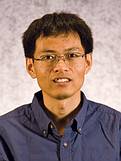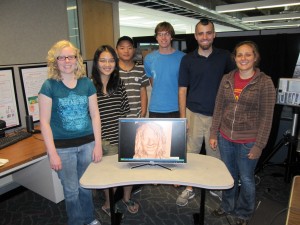
Imagine seeing live, three-dimensional video of rapid phenomenon like a beating heart. Then, imagine being able to use that data to evaluate disease or even perform surgery.
A sensing technology with this sort of capability would need to be fast, and it would need to be precise. And if it is both of those things, it could be used for much more.
Song Zhang, assistant professor of mechanical engineering, is hoping to take his 3D technology to a new speed with the project “Dense superfast 3D sensing of extremely rapidly changing mechanical and biological scenes.” The project is supported by a $400,000 National Science Foundation CAREER award.
The sensing technique he is working to develop would capture images at kilohertz to megahertz speeds. To put it into perspective, one hertz completes a cycle in a second, and a megahertz is 1,000,000 times faster than that.
Differing from the 3D technology seen in movies and on newer 3D TVs, Zhang’s technology generates 3D images that users can interact with and manipulate.
Take an image of the heart, for example. Zhang is collaborating with researchers in St. Louis who study heart disease with a method that requires the heart to be immobilized. Clearly, this approach isn’t feasible for studying humans. Using Zhang’s high-speed 3D imaging to develop a virtual image of the beating heart would allow the heart to be studied in an immobile state.
“When all is said and done, this is a platform technology that can be applied to many different areas,” explained Zhang. “Superfast three-dimensional sensing technology could lead to major breakthroughs in fields important to public health and safety.”
What sorts of breakthroughs?
Improving surgeries involving the brain and spine by providing a clearer, more accurate live image of the area during surgery than a pre-scanned MRI or CT image. Providing surgeons with more intuitive situational awareness during robotic procedures. Even helping autistic children feel more comfortable socializing with others through a 3D model.
Beyond biology, high-speed imaging can also improve the design of earthquake-resistant structures, allowing engineers to create safer buildings for people to work and live in.
“As we continue to make progress on the technology, I’m planning to work with Sri Sritharan in civil engineering to gather experimental data to understand collapse of structures that happens suddenly during earthquakes. We intend to study weak structural members that initiate collapse when a building is overloaded during a seismic event. By understanding and preventing collapse, we can avoid unnecessary loss of lives in future earthquakes,” Zhang said.
There are also immediate applications to use the imaging to study wind energy, fluidics, inspections, and agriculture.

Zhang says he must first overcome the challenge of storing all the data generated by these high-resolution videos and images before the technology can go more mainstream. “3D is at least 10 times bigger than 2D video. Current hardware doesn’t have the capacity needed for general use of the technology,” he said. Zhang’s lab is also working on 3D video compression techniques to conquer this challenge. He also noted increasing the precision of the data collected will be important to focus on, especially when considering the technology could be used in biology or for inspections.
People will be introduced to the technology through interactive welcome messages during public events at Iowa State, such as tours of the Virtual Reality Applications Center. Zhang says he also plans to get students involved in summer internships. “Anything we can do to get more students interested in the engineering will serve the field well,” he said.
They may even see the technology in less conventional places, like Radiohead’s “House of Cards” music video.
“I regularly get requests for collaboration that I have to evaluate and determine whether my technology is a good fit,” he said. “With faster, more precise imaging capabilities, we will be able to work with even more people and make this technology widespread.”
